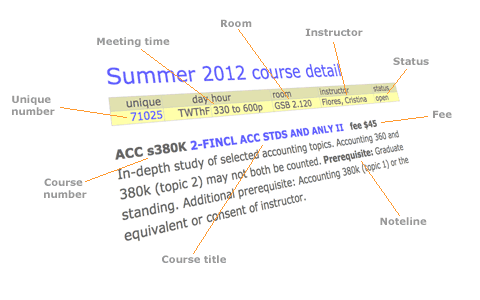The online course schedule provides general information about the university, such as registration procedures, fees and deposits, academic advising requirements, a list of classes containing a significant writing component, an index of final examination times, and grade reporting procedures. Read about these by pressing the links in the navigation bar along the side of any page in the schedule.
The schedule also lets you search for courses. A search will display class listings like the one below. Each class listing has a number of parts.
Most of the Course Schedule is devoted to class listings and associated information. In general, fields of study are arranged alphabetically by college and, within those divisions, alphabetically by department/academic program. Each academic area has a headnote that lists the administrative officers for the area, along with their office addresses and phone numbers. In many cases, important information about course prerequisites, descriptions, and enrollment restrictions is given in the headnote.

- Course numbers.
- These start with a field of study made up of one to three letters, and end with a three-digit number. Summer courses have a lowercase letter just before the number: f for first term, n for nine weeks, w for whole session, and s for second term. Note: Within a department, courses alphabetize by field, then sort by their last two digits. (So ACC 353J comes before ACC 179C.) In summer, s courses sort after f, n, and w courses.
- Course titles.
- Titles appear just after course numbers, and apply to all sections below them until a new course appears. For each course number, titles sort alphabetically. Those with topic numbers sort numerically.
- Notelines.
- On detail pages, notes may appear after a course title. These include course descriptions, prerequisites, enrollment and other restrictions, and cross-listed courses, and apply to all sections of the course.
- Unique number.
- A five-digit number which identifies a particular section of a course. (You'll need this number to register.) On results pages, pressing a unique number opens a page with class details.
- Meeting times.
- This appears next to a unique number. Weekdays are listed by their initial letters: MWF means a class meets Mon, Wed, and Fri all semester. (If it meets on additional days, on certain dates, or for only part of a semester, this will be noted on the details page.) Class hours follow the weekday. » Also see meeting time in the glossary.
- Rooms.
- The building and room come next. Buildings are abbreviated with three letters. » Also see the list of buildings and their abbreviations.
- Instructor.
- When assigned, instructor information follows the room.
- Status.
- The real-time registration status of a course section displays online, and includes classes which are open, restricted to specific majors or students, closed, closed with a waitlist, or canceled.

